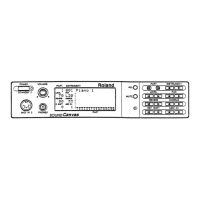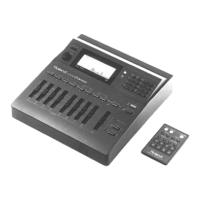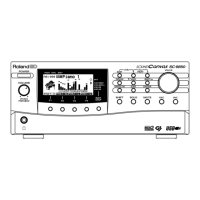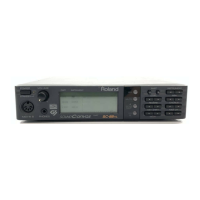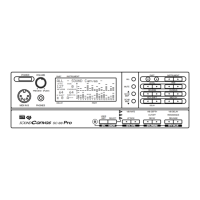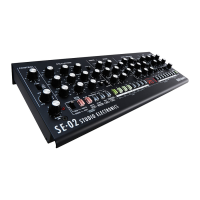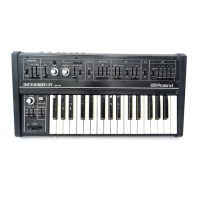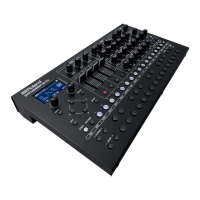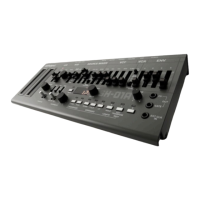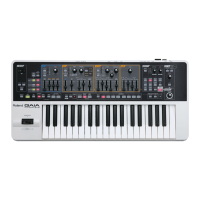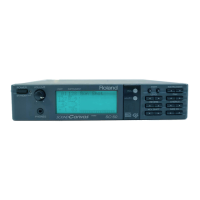
Do you have a question about the Roland Sound Canvas SC-50 and is the answer not in the manual?
| Type | Sound Module |
|---|---|
| Polyphony | 28 voices |
| Multitimbral | 16 parts |
| MIDI | In, Out, Thru |
| Headphone Output | Yes |
| Power Supply | AC Adapter |
| Wave Memory | 4MB |
| Effects | Reverb, Chorus |
| Output | Stereo |
| Sound Generation/Synthesis Method | LA synthesis, PCM |
| Preset Rhythms/Drum Sets | 9 drum sets |
| Display | 16 character LCD |
Important notes regarding unit usage and safety.
Essential operations for using the device.
How to perform specific convenient operations.
Explanation of the General MIDI System standard for sound generation.
Explanation of Roland's GS Format standard for sound generation.
Guidelines for safe and correct power supply usage.
Further warnings and safety advice for operation.
Description of the front panel controls and display.
Description of the rear panel connectors and ports.
Step-by-step guide to powering the unit on.
Explanation of MIDI connector functions and types.
How to connect audio output devices to the unit.
How to connect audio input devices to the unit.
Guide to connecting with Apple Macintosh computers.
Guide to connecting with IBM PC/AT computers.
Explanation of the COMPUTER switch function and its usage.
How to connect and use headphones for audio output.
How to use the AC adapter cord hook for cable management.
Instructions for rack-mounting the unit.
Step-by-step instructions for ROM playback.
Guide to choosing instruments for each part.
Adjusting the overall volume level of all parts.
Adjusting the overall stereo panning of all parts.
Guide to setting the reverb effect level.
Guide to setting the chorus effect level.
Adjusting the transposition amount for all parts.
Relationship between parts, instruments, and MIDI channels.
Guide to choosing instruments for each part.
Using MIDI devices to select instrument variations.
Overview of drum sets and their usage.
Guide to selecting a drum set for playback.
Using MIDI messages to change drum sets.
Setting the drum part number for playback.
Adjusting the volume level for each part.
Adjusting the stereo panning for each part.
Adjusting the reverb effect for each part.
Adjusting the chorus effect for each part.
Transposing individual parts using key shift.
General procedure for setting part parameters.
How to change settings within the USER function.
How to clear USER settings and revert to defaults.
Muting all parts simultaneously during playback.
Muting a single specified part during playback.
Locking mute settings against system reset messages.
Listening to a specific part for monitoring.
Listening to all parts simultaneously for monitoring.
Setting the master tuning frequency.
Fine-tuning the pitch of the unit.
Initializing the General MIDI settings to defaults.
Initializing the GS format settings to defaults.
Procedure to reset all settings to factory defaults.
Procedure for changing the patch name.
Procedure for saving current sound parameters.
Procedure for loading saved sound parameters.
Options for setting the bar display type.
Instructions for setting display parameters.
Procedure for adjusting the display contrast.
Guide to selecting instrument variations.
Using MIDI devices to select instrument variations.
Enabling/disabling instrument change reception via MIDI.
Setting the pitch bend range.
Adjusting modulation depth.
Adjusting velocity depth.
Adjusting velocity sensitivity depth.
Selecting mono or polyphonic mode.
Enabling/disabling portamento for pitch glide.
Adjusting expression parameters for dynamic control.
General instructions for setting output characteristics.
Adjusting vibrato rate, depth, and delay.
Adjusting the cutoff frequency of the sound.
Adjusting resonance for tonal shaping.
Adjusting attack, decay, and release times.
Adjusting the release time of the sound.
General instructions for setting sound parameters.
Choosing different reverb effect types.
Choosing different chorus effect types.
Information on the maximum number of simultaneous voices.
Order of priority for sounding parts when polyphony limit is reached.
Setting the voice reserve number for managing voices.
How to connect devices for data transfer.
Sending setup data to a sequencer.
Transmitting all parts and specific settings to sequencer.
Transmitting specific part settings to sequencer.
Transmitting all SOUND Canvas settings to sequencer.
Transmitting all parts and specified settings to sequencer.
Transmitting settings of a specified part to sequencer.
Procedure to change the MIDI reception channel for a part.
Solutions for common operational problems.
Explanations of error and system messages.
General information about MIDI technology and its use.
